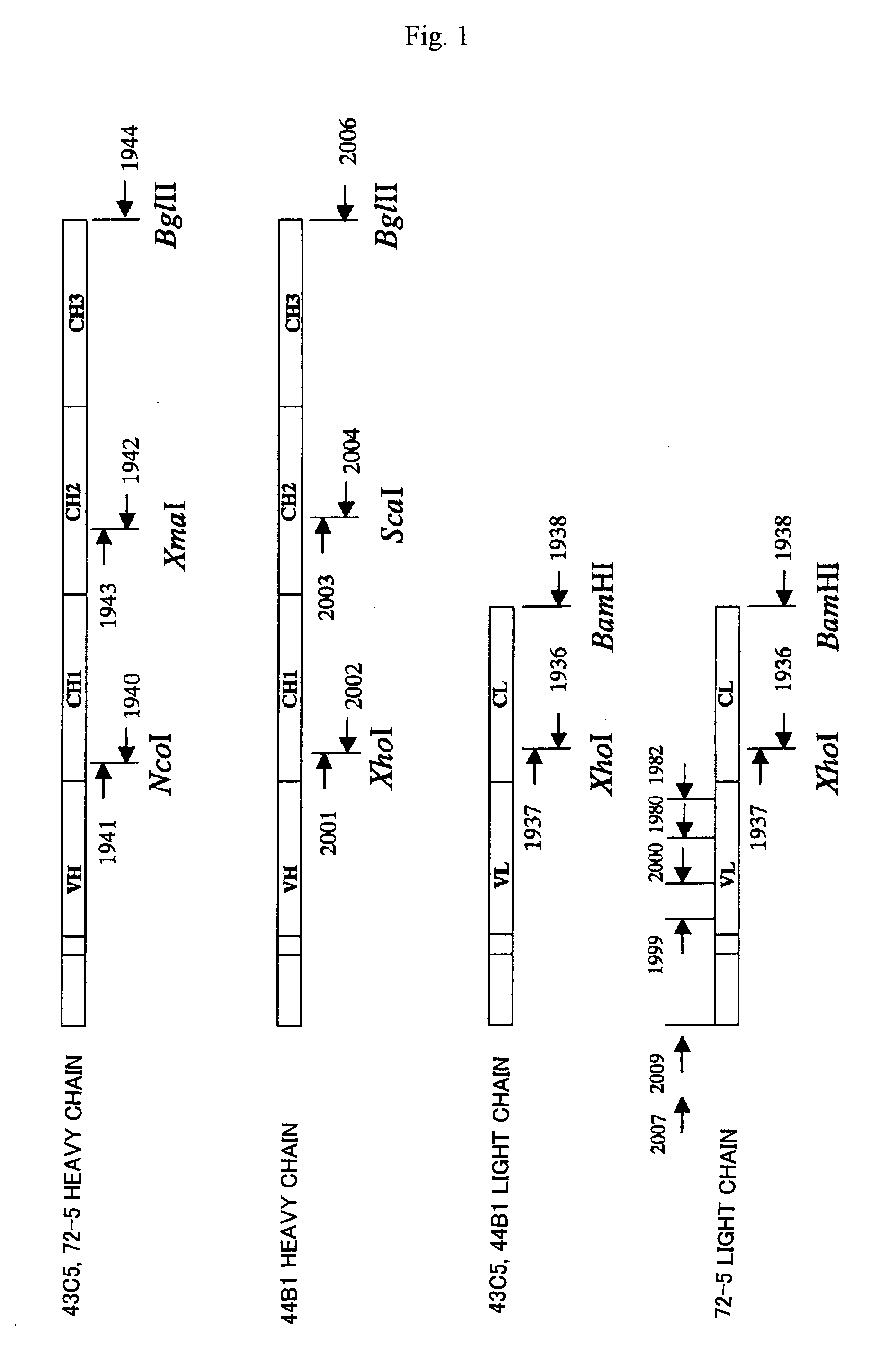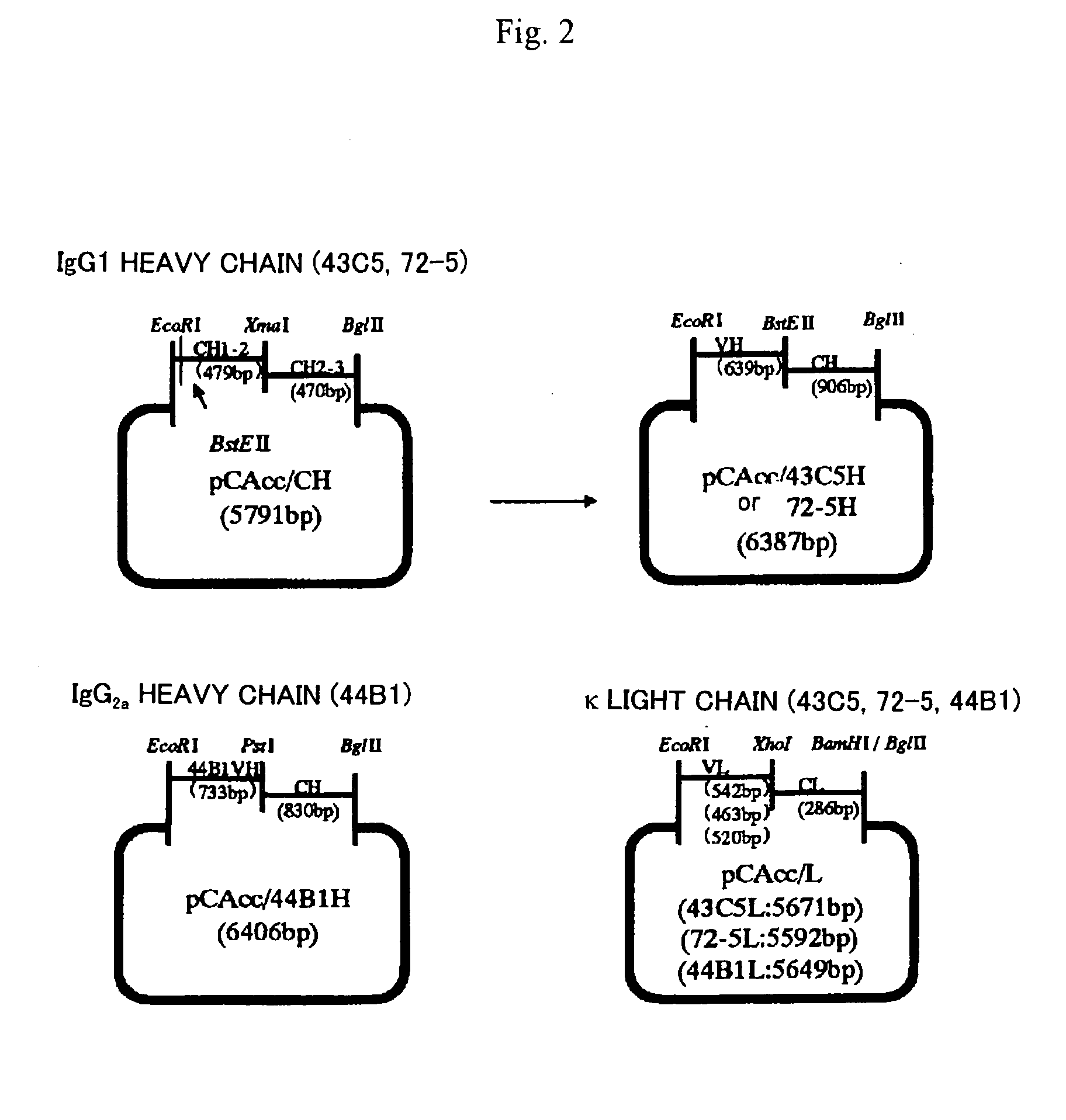Remedy for prion disease and method of producing the same
a prion disease and drug technology, applied in the field of prion disease, can solve the problems of suppressing the expression of prpsup>c/sup>, affecting the treatment effect, and bse infection in humans has become a serious problem, etc., to achieve excellent effects, delay the progression of symptoms, and contribute to medical and veterinary fields.
- Summary
- Abstract
- Description
- Claims
- Application Information
AI Technical Summary
Benefits of technology
Problems solved by technology
Method used
Image
Examples
example 1
Production of Anti-PrP Monoclonal Antibody-Producing Hybridoma
[0175] A prion protein knockout mouse (Prnp− / − mouse) was immunized with, as an antigen, purified recombinant PrP (rPrP) or purified abnormal prion protein (PrPSc) from the brain of a scrapie Obihiro strain-infected mouse, spleen cells thus obtained and a myeloma cell line (P3U1) were fused to give a hybridoma, and this was screened with respect to its ability to bind to PrP (ref. Kim et al. 2004. Virology 320: 40-51).
(1) Antigen Preparation
[0176]E. Coli was made to express a recombinant polypeptide (rPrP) corresponding to positions 23 to 231 of mouse PrP using E. Coli expression vector pRSETB (manufactured by Invitrogen). Since the rPrP was expressed in an inclusion body, this was solubilized by 8 M guanidine hydrochloride and purified with Ni2+-IMAC. The purified product was subjected to reverse-phase HPLC with respect to one having an SS bond within the molecule to give further purified rPrP as an antigen (ref. Kim...
example 2
PrPSc Growth Inhibitory Activity of Anti-PrP Monoclonal Antibody
[0179] Among antibodies obtained in Example 1, one having PrPSc growth inhibitory activity was selected. I3 / I5 cells with a persistent prion infection (Race et al. 1987 J Gen Virol 68: 1391-9) were cultured in a medium containing a concentration of 0.1 to 10 μg / mL of anti-PrP monoclonal antibody for 3 days. After the medium was removed, the cells were washed with PBS, dissolved in a buffer solution containing 0.5% Triton-X100 and 0.5% sodium deoxycholate, and digested with 20 μg / mL of protein kinase K at 37° C. for 20 minutes. After the activity of the protein kinase K was terminated by adding 2 mM of Pefablock, PrPSc was collected by centrifugation at 100,000×g for 2 hours. PrPSc was detected by the Western blot method.
[0180] Among Examples below, three types of hybridomas, that is, 43C5 (IgG1), which did not show PrPSc growth inhibitory activity, and 72-5 (IgG1, Depository No.: FERM P-18516) and 44B1 (IgG2a, Deposit...
example 3
Identification of Anti-Prion Antibody Gene
[0181] Total RNA was prepared from the hybridoma selected in Example 2 in accordance with a standard method, and antibody genes (heavy chain, light chain) were cloned by a 5′-RACE (Rapid Amplification of cDNA End) method and an RT-PCR method respectively. The 5′-RACE method was carried out using a SMART® RACE cDNA Amplification Kit (manufactured by CLONTECH). The primers shown below were prepared for cloning antibody genes. FIG. 1 shows the correlation between antibody genes and primers.
TABLE 1List of primers used for cloning of anti-PrPantibody genes1936 (SEQ ID NO:9): 35mer5′-TCACTCGAGGGTGGGAAGATGGATACAGTTGGTGCA1937 (SEQ ID NO:10): 32mer5′-ACCCTCGAGTGAGCAGTTAACATCTGGAGGTG-3′1938 (SEQ ID NO:11): 36mer5′-CGCGGATCCTTAACACTCATTCCTGTTGAAGCTCTT-1940 (SEQ ID NO:12): 23mer5′-CTTGACCAGGCATCCCAGGGTCA-3′1941 (SEQ ID NO:13): 25mer5′-CCTGGATCTGCTGCCCAAACTAACT-3′1942 (SEQ ID NO:14): 25mer5′-CGGAAAGTGCTGTTGAACTGCTCCT-3′19...
PUM
| Property | Measurement | Unit |
|---|---|---|
| pH | aaaaa | aaaaa |
| temperature | aaaaa | aaaaa |
| concentration | aaaaa | aaaaa |
Abstract
Description
Claims
Application Information
 Login to View More
Login to View More - R&D
- Intellectual Property
- Life Sciences
- Materials
- Tech Scout
- Unparalleled Data Quality
- Higher Quality Content
- 60% Fewer Hallucinations
Browse by: Latest US Patents, China's latest patents, Technical Efficacy Thesaurus, Application Domain, Technology Topic, Popular Technical Reports.
© 2025 PatSnap. All rights reserved.Legal|Privacy policy|Modern Slavery Act Transparency Statement|Sitemap|About US| Contact US: help@patsnap.com



